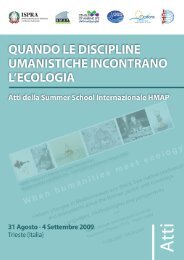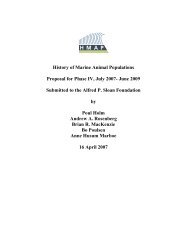The Danish fisheries c.1450-1800. Medieval and early modern ...
The Danish fisheries c.1450-1800. Medieval and early modern ...
The Danish fisheries c.1450-1800. Medieval and early modern ...
Create successful ePaper yourself
Turn your PDF publications into a flip-book with our unique Google optimized e-Paper software.
around 50,000 barrels, peaking at 60,000 barrels in 1586. <strong>The</strong> trade then rapidly declined <strong>and</strong><br />
virtually ceased by 1589, although a couple of years in the 1590s did see herring coming from<br />
Bohuslen. <strong>The</strong> Dutch had a superior product <strong>and</strong> the Bohuslen fish merchants were no match<br />
to them.<br />
<strong>The</strong> appearance <strong>and</strong> ultimate disappearance of the Bohuslen herring was probably<br />
caused by the natural periodicity of the stock, which seems to have been linked with the North<br />
Atlantic Oscillation. 5 However, the background importance of the disappearance of the Dutch<br />
on the market <strong>and</strong> their reappearance in the 1590s cannot be neglected when considering the<br />
scale <strong>and</strong> duration of the Bohuslen fishery. While the beginning of the fishery was slow <strong>and</strong><br />
conceivably reflected increased abundance, the collapse of the fishery <strong>and</strong> the lingering<br />
presence of catches in the 1590s indicates the force of suddenly changed market<br />
circumstances. By analogy to the Aalborg evidence of the Baltic <strong>and</strong> Norway markets, the<br />
Bohuslen fishery may have continued to a degree in spite of the loss of the Baltic market as<br />
reflected in the Sound Toll Records. A combination of natural <strong>and</strong> economic causes seem to<br />
have contributed to the specific development of the sixteenth-century Bohuslen herring<br />
period.<br />
<strong>The</strong> Sound fishery<br />
Another background to the Bohuslen fishery was the decline of the largest <strong>Danish</strong> fishery, the<br />
Sound fishery for herring, in the second half of the sixteenth century. <strong>The</strong> exact timing of the<br />
decline is yet unknown, but signs of a crisis were recorded in 1547. An estate meeting of 1558<br />
still stipulated the free access to the herring market of the Sound as the first privilege of the<br />
nobleman. By the 1580s the herring town of Stege was in a slump due to the crisis of the<br />
5Brian R. MacKenzie (1), Jürgen Alheit (2), Daniel J. Conley (3), Poul Holm (4), Carl<br />
Christian Kinze, Ecological Hypotheses for a Historical Reconstruction of Upper Trophic<br />
Level Biomass in the Baltic Sea. Canadian Journal of Fisheries <strong>and</strong> Aquaculture Science






